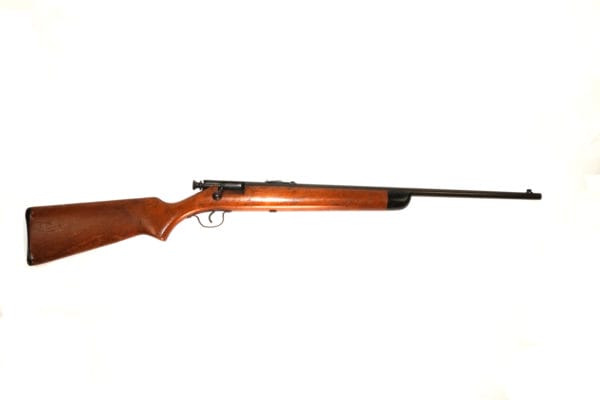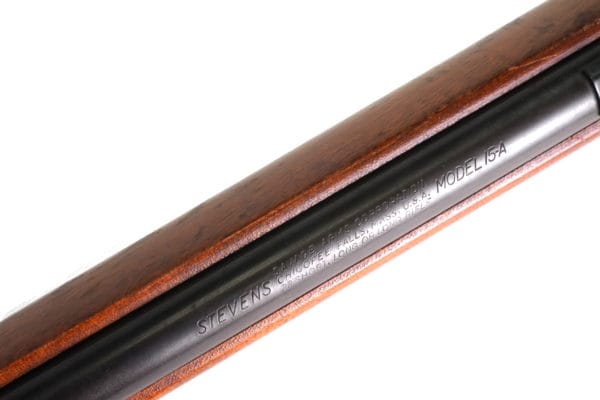U.S.A. –-(Ammoland.com)- Ask anyone what kind of gun was used when they learned how to shoot as a child and they will almost always say it was some kind of .22-caliber pistol or rifle. Because a .22 is such a soft-shooting round, it’s perfect for teaching children (and adults) the fundamentals of marksmanship without scaring them away with loud noise or harsh recoil.
In the early 20th century, one such popular rifle was the Stevens Model 15, which was an affordable, easy-to-use, single-shot rifle.
The Model 15 was intended for the boy’s rifle market. Early models had a 22” barrel and later models had a 24” barrel. Regardless of barrel length, they usually tipped the scales at less than four pounds. Technically a bolt-action, it was a simple single-shot design. The bolt operated like any other bolt-action rifle, except that after extracting the fired cartridge case, there was no magazine that would allow the loading of another cartridge. Instead, the next round had to be manually loaded.

For the first ten years of production, which were 1937 to 1947, it was billed as the Springfield Model 15. In 1948, it became known as the Stevens Model 15, and remained as such through 1965.
In other instances, the rifle was known as the Model 120, and thousands were manufactured as “store brand guns” for companies such as Sears, Montgomery Wards, J.C. Penney, and others, through 1971.
This particular gun is a Stevens Model 15-A. The exact year of production is unknown because it was made before Federal law required each gun to have a serial number, but we do know that it was made some time before 1958. We know this because the gun shows up in old family photos that are positively dated to that year.
Now, the gun in and of itself as an example of a run-of-the-mill Stevens Model 15-A is rather unremarkable, having virtually no collector value and a resale value of $100 or so. What makes this particular gun so special is the person who learned to shoot with it.
This Stevens Model 15-A belonged to a family from Arkansas, and one of the boys who learned to shoot with this gun was Carlos Norman Hathcock II.
Born in 1942, Hathcock enlisted in the Marine Corps on May 20, 1959 – the very day he turned seventeen. His previous skill as a marksman had won him a variety of matches and trophies at places like Camp Perry in Ohio. His proficiency with a rifle gained the attention of Edward James “Jim” Land, one of Carlos’ commanding officers in Vietnam, who trained him in an early version of a sniper school.
By the time he left Vietnam for the second – and final – time in 1969, Carlos had cemented his legacy as one of the most accomplished Marine Corps snipers of all time, with a total of 93 confirmed kills. The key word there is “confirmed,” as Carlos estimates his actual number to be somewhere between 300 and 400.

It was not uncommon for Carlos to spend days on end inching through fields toward the enemy, so well disguised that he was almost stepped on by a Vietnamese soldier one time and almost bitten by a viper another time.
Locally, he became known as “Long Tr’ang” – or “White Feather” – because he kept one in his hat band at all times while in country. Hathcock’s skill as a sniper quickly made him “Public Enemy #1” to the Vietnamese. They even went so far as to offer a bounty on his head worth a staggering equivalent of $30,000. Normally, bounties rarely got higher than a few thousand dollars.
By far, the most impressive shot he ever made was when he took out an enemy sniper who had been dispatched to kill him. While lying in wait, Carlos caught a glimpse of light that flashed off of the enemy’s scope. After making the shot, it was discovered that Hathcock’s round went right down the center of the scope and struck the enemy sniper in the eye, killing him instantly.
It’s important to note, however, that just because Hathcock was good at what he did, didn’t mean that he was heartless or relished in the killing of human beings. In an interview, he said, “I like shooting, and I love hunting. But I never did enjoy killing anybody. It’s my job. If I don’t get those bastards, then they’re gonna kill a lot of these kids dressed up like Marines.”
Carlos left Vietnam in 1969 after being badly injured and burned when a vehicle he was riding in struck an anti-tank mine. He pulled seven fellow Marines from the fiery wreck and received the Purple Heart for his actions; a Silver Star came decades later.
Once he recovered and was firmly reestablished back in the United States, Hathcock helped Jim Land establish the Marine Corps Scout Sniper School in Quantico, Virginia. In 1975, he was diagnosed with multiple sclerosis and was medically retired from the Marine Corps.

Despite the pain from his disease, Carlos continued to offer sniper training to military and law enforcement agencies throughout the country for the rest of his life. In 1999, he lost his battle with MS at just 56 years old.
Carlos Hathcock’s story is the ultimate testament to what can be done when a small spark from a small gun like the Stevens Model 15-A ignites the passion for marksmanship.
Donated by his brother, Billy Jack Hathcock, the visually unremarkable rifle on which one of the Marine Corps’ most celebrated snipers of all time learned to shoot is in the collection of the National Museum of the Marine Corps in Quantico, Virginia.
About Logan Metesh
Logan Metesh is a historian with a focus on firearms history and development. He runs High Caliber History LLC and has more than a decade of experience working for the Smithsonian Institution, the National Park Service, and the NRA Museums. His ability to present history and research in an engaging manner has made him a sought after consultant, writer, and museum professional. The ease with which he can recall obscure historical facts and figures makes him very good at Jeopardy!, but exceptionally bad at geometry.


Carlos Hathcock was a true American hero and a legend in his own time. God bless his soul. I wish I could have met him.
Sgt. Hathcock was an outstanding Marine. It should be noted he accomplished his tally in a lot less time than most others in his field. Not to downplay the results of others but Carlos’ accomplishments was with basic rifles with simple 3 X 9 scopes. I salute the memory and the man. Semper Fi Carlos.
Really surprised to see article of the Savage Stevens Model 15-A. I am 69 years old, an am proud to say it was my first rifle my father purchased for me, I was 10 years old. I am happy to say that I still have my Model 15-A. I have the 24 in. barrel. I became a very good shot with that .22. The rifle will shoot .22 Short, .22 Long and .22 Long Rifle. I was challenged one time to shoot a Duck in a lake, the Duck was easy 100 yds. in the middle of the lake. The… Read more »
My first rifle was a Marlin.22. I was raised that you had a rabbit/pheasant for every round. I could light stick matches – not every shot. Had a bet shooting skeet with a .22 and got 18 out of 20. Joined the Marines, was series high shooter in boot camp. Am left handed and wear glasses. The shell casings bounced off my right cheek with the M16A1. LtCol asked if I owned any guns. Told him I was hunting foxes for a living right before I joined. Became a 0352 and a heavy weapons instructor and TAD as rifle and… Read more »
Hathcock was in Uncle Sam’s Misguided Children outfit two years before me. Although we served during those ‘Nam years, I never crossed paths with him – would liked to have met him! He was diagnosed with MS six years before me, quite the coincidence! Unlike Carlos, and fortunate for me, my MS has remained in remission once I retired from the Corps. Hardly seems possible that Carlos has been gone for 20 years now. Oh yea, that Springfield. Mine was a Winchester model 67 that was my uncle’s “Target,” as described by my grandmother. I cut my teeth on that… Read more »
How to find when the Stevens early rifles were made.
https://www.go2gbo.com/forums/139-savage-rifles-shotguns/103683-savage-stevens-date-codes.html
Except for some minor differences it looks like my Stevens Westpoint Model 121 which was made in 1966 by the date code on the barrel.
https://photos.app.goo.gl/nXkctD72atNxcP1G8
My mistake. Mine was made in 1965 and my Father bought it for me in 1966.
S = 1965, 40 may be the week of the year. In October?
https://photos.app.goo.gl/LJeFiH5cayGQg37E6
Boy did this article bring back memories. I had the same rifle when I was a kid. Unfortunately it was stolen from my home. Funny coincidence though, my father is from Arkansas.
One of my favorite single shots because it was easy to reload quickly for a southpaw rifle shooter like me.